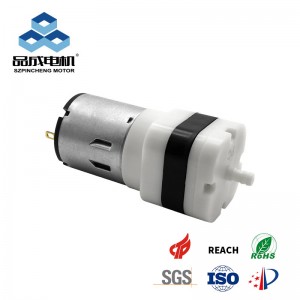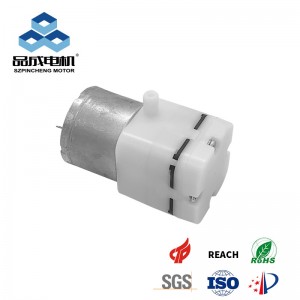Micro vacuum pumps supplier
Last year, a pure electric bus encountered a sudden failure of brake assist on a continuous downhill section of the Yunnan-Guizhou Plateau. Investigation found that the root cause was a single vacuum controller failure that caused the vacuum pump to stop, and the small-volume vacuum tank had insufficient energy storage, which almost caused a major accident1. This case exposed the design risks of traditional vacuum assist systems and also made the industry begin to re-examine the key role of micro DC vacuum pumps in automotive electronic assist systems.
Why do electric vehicles have to rely on micro vacuum pumps?
In traditional fuel vehicles, the engine intake manifold naturally generates negative pressure, providing a free vacuum source for the brake assist system4. However, electric vehicles do not have an engine, and without a vacuum source, the brake pedal becomes extremely heavy - the braking force of manual braking alone is far from meeting safety requirements.
At this time, a micro DC vacuum pump becomes the only solution:
Electric drive: directly use the vehicle's 12V/24V power supply, drive the piston or diaphragm to move at high speed through the motor, and actively extract vacuum3;
Quick response: For example, HD-PC3025N can establish a negative pressure of -70kPa within 1 second to meet emergency braking needs3;
Independent energy supply: not limited by engine operating conditions, it can work even when the vehicle is stationary
How do micro vacuum pumps overcome obstacles and meet stringent automotive requirements?
1. Performance indicators: balance between vacuum and flow
Plateau Challenge: At an altitude of 3,000 meters, the atmospheric pressure drops to about 70kPa (101kPa on the plain). If the nominal vacuum of the pump is only -50kPa, the actual effective negative pressure will decay to -20kPa, resulting in a serious lack of brake assist. Therefore, it is necessary to select a model with a vacuum of ≥-70kPa (such as PC3025N) to leave a safety margin.
Flow attenuation: For a pump with a nominal flow of 25L/min, the actual flow may drop to 15L/min after connecting a 1-meter pipe + 2 elbows. During continuous braking (such as a long downhill), if the flow is insufficient and the vacuum tank pressure cannot be maintained, the brake alarm will be triggered.
2.Reliability: Double insurance of durability and failure prevention
1500-hour endurance test: Ruhaizhibo iEVP Pro has been optimized with graphite rotors, and its lifespan exceeds that of international competitors
Step 2: Match vacuum & flow
Quick check table (taking Pincheng common models as an example)
Dual controller redundant design: The new system uses two parallel vacuum controllers. If one fails, the other can still control the pump to work, eliminating single point failure
Intelligent load reduction strategy: When a vacuum leak (abnormal pressure gradient) is detected, it automatically switches to intermittent operation mode to prevent the motor from burning out
Environmental adaptability: from extreme cold to high humidity
Water vapor tolerance: The brake system may inhale humid air, and ordinary pumps are prone to rust. However, PC mini vacuum pump allows the medium to be "rich in water vapor" and uses fluororubber seals inside.
-30℃ cold start: brushless motor pumps (such as VML series) can still respond quickly at low temperatures, avoiding the risk of solidification of traditional hydraulic systems
3. Real Challenges: Bottlenecks and Solutions of Micro vacuum pumps
Although the technology is mature, micro pumps still face three major pain points in application:
Energy consumption and NVH (noise and vibration) conflict
High-flow pumps often have a power of more than 40W, and continuous operation consumes significant power (accounting for about 0.5% of the electric vehicle's range). At the same time, motor noise may be transmitted to the cockpit. Solutions:
Brushless motor + variable frequency control: For example, the VML series reduces idle power consumption by speed regulation7;
Soundproof cover + hose vibration reduction: a common solution for OEMs.
Overheating risk in plateau and leakage scenarios
In plateaus or when the seal fails, the pump may overheat due to long-term operation. The new controller intelligently stops the pump through pressure gradient monitoring:
If the pressure drop gradient is less than 8mbar/s within 10 seconds of operation, the system is judged to be normal and the pump is stopped immediately;
If the gradient is abnormal (leakage), it will enter the "work 15 seconds + stop 10 seconds" protection cycle4.
Game of space and cost
Large-flow pumps (such as PC3025N) weigh 1kg and occupy chassis space. Although the dual controller + large-volume vacuum tank solution improves reliability, the cost increases by about 30%15. The industry trend is integrated design: Haizhibo embeds the controller into the pump body to reduce wiring harnesses and interfaces6.
Future direction: not just a "backup role"
With the upgrade of intelligent driving, the functions of micro vacuum pumps are expanding:
Redundant backup for autonomous driving above level L3: When the electronic hydraulic brake fails, the vacuum booster system takes over as a mechanical backup7;
Active suspension air supply: Some models use the same vacuum pump to power the air spring, realizing "one pump for multiple uses"6;
Hydrogen fuel cell vehicle hydrogen circulation: Corrosion-resistant micro pumps are used in the hydrogen circulation system to improve fuel utilization3.
Conclusion: Key components, but system-level optimization is required
Micro DC vacuum pumps fully meet the power assistance needs of modern electric vehicles, but they must be "selected according to the symptoms":
Family cars: PC3025N level (-70kPa, 25L/min) with a single controller + 8L vacuum tank is enough8;
Commercial vehicles/highland models: require pumps above -80kPa + dual controllers + 15L large vacuum tanks, and configure pressure gradient monitoring14;
Future smart cars: brushless motor pumps (such as VML) will become mainstream, taking into account efficiency, quietness and intelligent control67.
As the consensus of engineers: No matter how strong the performance of a single pump is, it is not as good as the system coordination of "pump-tank-controller-sensor". When choosing, you should not only look at the nominal parameters of the pump, but also verify its load capacity and fault response mechanism in the whole vehicle system-after all, the milliseconds between brakes determine the safety margin of life.
Shenzhen Pincheng Motor has many years of experience in the R&D and production of micro vacuum pumps, and has passed the automotive certification IATF 16949, which can provide good solutions for the production of automotive parts.
you like also all
Read More News
Post time: Jun-19-2025




